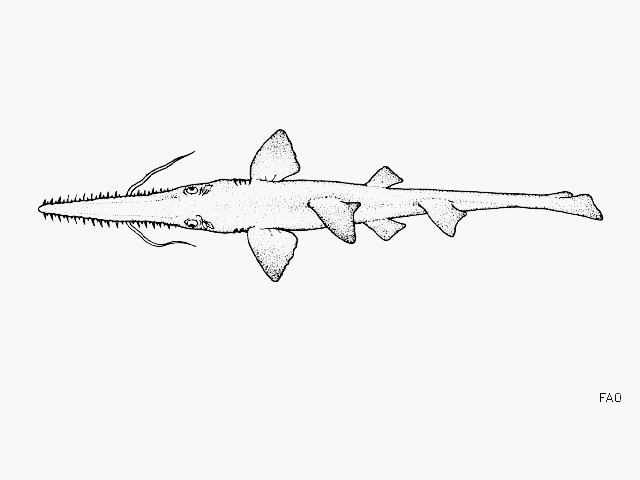| Pristiophoridae (Saw sharks) |
| 137 cm TL (male/unsexed); max. reported age: 15 years |
|
demersal; marine; depth range 37 - 310 m |
| Eastern Indian Ocean: southern Australia (Ref. 6871). Does not occur in the Western Central Pacific (Ref. 31368). |
|
Pristiophorus cirratus has a long, narrow, and narrowly tapering rostrum (rostrum length is 27-29% of TL), distance from rostral tip to barbels about equal or slightly greater than distance from barbels to mouth (1:1.2-1.3); distance from rostral barbels to nostrils slightly less or equal to distance from nostrils to 1st to 4th gill slits. About 9-10 large rostral teeth on each side of the rostrum in front of the barbels, 9 behind them; distance from mouth to nostrils 1.3-1.4 times internarial space. Tooth rows 39-49 in upper jaw. Dorsal and pectoral fins covered with denticles in large specimens. Lateral trunk denticles largely unicuspidate. First dorsal fin origin behind free rear tips of pectorals by eye length or more (Ref. 247).
P. cirratus has a body pattern of dark blotches (mostly darker bands between pectoral fin bases, over gill slits, between spiracles and below dorsal fins) and spots (occasionally faint). Nostrils, almost circular, are situated about 2/3 way from barbels to corner or mouth, width at nostrils more than 4.5 in preoral snout in adults; preoral snout length more than 2.3 times distance from barbels to snout tip (Ref. 6871). Rostral teeth with dark margins; underside abruptly uniformly white (Ref. 41394). First dorsal fin origin behind free rear tips of pectorals by eye length or more (Ref. 247). Caudal fin almost straight, with slender upper and lower lobes; pectoral well developed but are not ray-like (Ref. 6871). |
| Found on the continental shelf and upper slope. Forms schools. Feeds on small fishes, including cornet fishes (Fistularia), and crustaceans. Ovoviviparous, with 3-22 young in a litter (48360). Size at birth about 31-34 cm. May live for more than 15 years. Meat marketed fresh and frozen. |
|
Least Concern (LC); Date assessed: 14 April 2015 Ref. (130435)
|
| harmless |
Source and more info: www.fishbase.org. For personal, classroom, and other internal use only. Not for publication.
